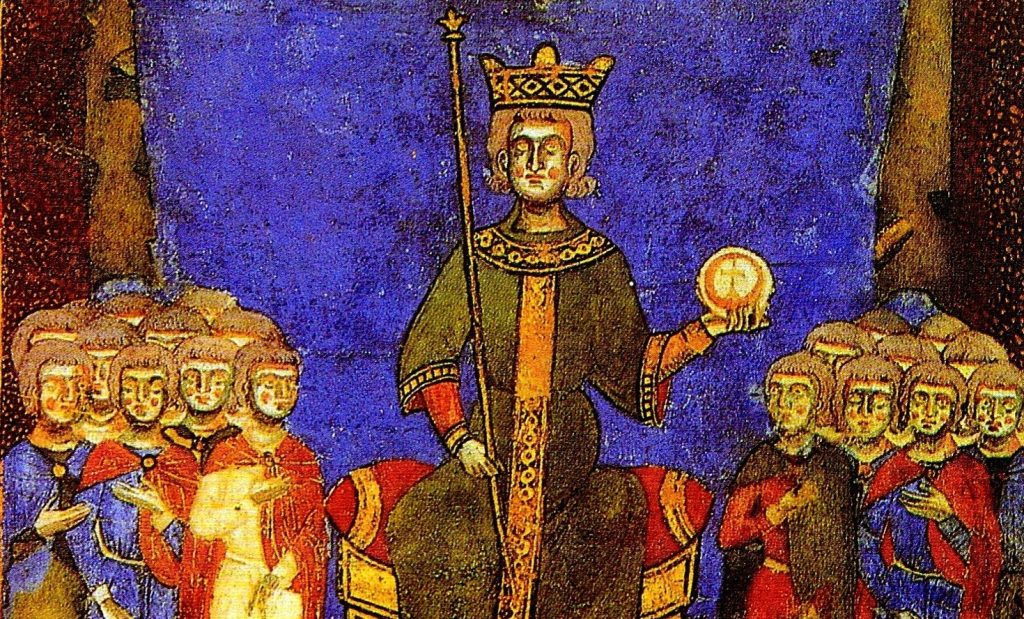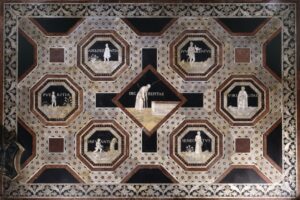Federico II di Svevia: un sovrano poliedrico
8 min read
Re di Sicilia, re d’Italia e imperatore del Sacro Romano Impero nella prima metà del 13° secolo, Federico II di Svevia (1194-1250) non è una personalità affatto semplice da inquadrare. Fra i numerosi, e spesso discordanti, epiteti a lui rivolti dai cronisti vale la pena menzionare quello che forse mette d’accordo i più: per la storiografia e per l’opinione comune egli è lo Stupor Mundi, la “meraviglia del mondo”.
Di questa figura quasi mitica stupisce una poliedricità poco comune per un sovrano del suo tempo che si traduce in spiccata curiosità e instancabile voglia di conoscere. Egli è giustamente dedito all’amministrazione politica e all’assetto giuridico del suo grande impero (successore del padre Enrico VI in Germania e in Italia, ed erede del regno normanno di Sicilia per tramite della madre Costanza d’Altavilla) ma, al tempo stesso, è aperto al dialogo e al confronto con i vicini regnanti nordafricani e si adopera in ogni modo per far proliferare i saperi provenienti dal mondo greco e da quello arabo infoltendo la sua corte di sapienti traduttori.
La gestione del potere
Sulla scia di un processo già avviato durante la dinastia normanna (1061-1198), Federico II tenta innanzitutto di dare un ordinamento giuridico e amministrativo al regno del Sud Italia (a cui egli rivolge buona parte del suo interesse e del suo operato) appoggiandosi alla tradizione romana. Fra le disposizioni da lui emanate, quella più spiccatamente ‘moderna’ risulta essere il trattamento giuridico paritario concesso indistintamente ai cristiani, agli ebrei e ai musulmani di Sicilia e sancito all’interno del più importante corpus di leggi del Medioevo: il Liber Augustalis (1231, Melfi), anche conosciuto come Costituzioni Melfitane.
Parimenti, la sistematizzazione di tali leggi dimostra la volontà di Federico II di cambiare lo status quo: egli sottrae ai nobili feudatari le loro tradizionali prerogative e trasferisce posizioni di prestigio a notai e giuristi di estrazione borghese (non aristocratica) i quali diventano i principali amministratori del potere dopo il re, in veste di ministri. Solo questi ultimi, col beneplacito del re, possono, ad esempio, amministrare la giustizia ed emanare sentenze.
Contemporaneamente, egli opta per la suddivisione del regno di Sicilia in circoscrizioni gestite da poteri locali nominati, e controllati, dall’alto. In questo modo, egli si circonda di una schiera di burocrati ‘fidati’ e riesce nel suo intento di centralizzare il potere intorno alla sua figura, figura che tenta in tutti i modi di assimilare alla grandezza dell’imperatore romano Augusto.
L’incontro-scontro con l’Islam
La ‘modernità’ di Federico II in quanto imperatore cristiano e rappresentante di Dio sulla Terra (come egli si riconosce) si evince poi da un certo grado di tolleranza rivolta alle confessioni religiose non cristiane, come ben dimostra la natura multiculturale della sua corte itinerante, colma di scienziati e filosofi islamici ed ebrei.
Tuttavia, il rapporto fra l’imperatore cristiano e l’Islam non è esente da alcune complessità, sia nei riguardi della popolazione arabo-musulmana di Sicilia che verso gli ‘infedeli’ (così percepiti dalla cristianità medievale) residenti sull’altra sponda del Mediterraneo.
Sul fronte interno, già prima di Federico II, la comunità arabo-musulmana si restringe fortemente in termini numerici (sotto la dominazione normanna) e sopravvive in una posizione di subalternità. Così, al tempo dello Stupor Mundi, gli arabi siciliani si ritrovano a patire discriminazioni e cattive condizioni economiche. A soffrirne di più sono i contadini musulmani i quali sono ulteriormente svantaggiati dalle tasse introdotte dall’imperatore per finanziare l’insieme della macchina burocratica e delle iniziative culturali.
Atti di ribellione animano dunque sempre più il versante occidentale dell’isola fino a quanto Federico II prende una decisione di significativo impatto sociale: la deportazione fisica degli arabi siciliani fuori dall’isola e il loro reinserimento in una città pugliese, Lucera, la quale diviene per qualche decennio una roccaforte saracena.
Conosciuta come Luceria Saracenorum essa arriva ad ospitare (fino alla morte dell’ultimo erede di Federico II) un numero oscillante dai quindicimila ai trentamila saraceni i quali riprendono qui le loro consuete attività agricole e d’artigianato traendo vantaggio dalle potenzialità commerciali del posto e dal clima di libera professione dell’Islam, incoraggiato dalla presenza di moschee e muezzin.
Sul fronte esterno invece l’imperatore non può esimersi dall’impegno di scacciare gli arabi ‘infedeli’ dalla Terra Santa (la cui conquista è agognata dai rappresentanti della cristianità) e non può che rispondere all’appello di papa Gregorio IX (papa dal 1127 al 1241). In questo contesto, Federico II si rende protagonista della sesta crociata (1228-1229) dopo aver rimandato più di una volta, per circostanze vuoi casuali vuoi intenzionali, la partenza.
Egli si distingue anche in questa occasione mostrando un atteggiamento di inusuale diplomazia riuscendo a combattere senza armi e senza versare sangue. Inviando a negoziare un suo collaboratore fidato, l’arcivescovo di Palermo Berardo di Castagna, Federico II riesce a trovare un accordo con il sultano d’Egitto Al-Kāmil traendo vantaggio da alcune circostanze favorevoli (Al- Kāmil è in combutta con suo fratello, regnante nella vicina Damasco, e vede in un’alleanza con l’imperatore cristiano uno strumento per frenarne le ambizioni).
La speciale conduzione della crociata ha esito positivo: il mondo cristiano acquisisce il controllo di Gerusalemme, Betlemme, Nazaret, Sidone e gli altri luoghi sacri (ad eccezione della Spianata delle Moschee che resta zona di libero transito) e, contemporaneamente, Federico II viene incoronato re di Gerusalemme grazie alle seconde nozze con Isabella II di Brienne (figlia del re di Gerusalemme Giovanni di Brienne) avvenute nel 1225.
Va detto che questa speciale nomina avviene in un contesto poco piacevole per l’imperatore che si trova in quel momento scomunicato dal papa per le sue presunte tendenze eretiche e collusioni con gli ‘infedeli’. In generale, i rapporti tra Federico II e la Chiesa papale, ad eccezione della parentesi felice della sua infanzia (Federico II resta orfano in tenera età e la sua crescita viene affidata all’allora papa Innocenzo III), sono noti per essere estremamente tesi e conflittuali, tanto che prende piede l’idea che egli sia assimilabile ad un ‘anticristo’.
La fioritura di centri culturali e letterari
La poliedricità dello Stupor Mundi appare forse a più forte ragione in ambito culturale. A lui si deve il merito di aver dato impulso alla nascita di centri culturali di grande spessore, dalle università alla celebre Scuola Poetica Siciliana.
Affianco alle già esistenti (primissime) università del continente, quelle di Bologna (1088) e di Padova (1222), egli favorisce la fondazione dell’università di Napoli (non a caso oggi intitolata a Federico II), dove si recano a formarsi i futuri funzionari dell’imperatore, e quella di Salerno che in poco diventa un centro di riferimento per lo studio della medicina.
Ma la sua reputazione si lega a doppio filo alla nascita, presso la sua corte di Palermo, della celebre Scuola Poetica Siciliana dove alcuni verseggiatori dilettanti (non perché impreparati ma perché impegnati nella pratica letteraria per diletto) si ispirano alla poesia dei trovatori provenzali (in voga nelle corti aristocratiche dell’Italia settentrionale) e compongono per la prima volta forme poetiche inedite (i sonetti) in lingua volgare.
Ciò è rivoluzionario in quanto rappresenta il primo tentativo di conferire dignità letteraria ad un volgare regionale: si tratta, in realtà, di un “volgare siciliano illustre” poiché depurato da ogni espressione rozza o ‘grossolana’, o da connotati eccessivamente materici, per lasciare spazio ad una certa astrattezza evocativa volta a celebrare sentimenti d’amore per una dama dalle fattezze sublimate.
La Scuola non ha vita molto lunga (si estende per non più di un trentennio dal 1225/’30 al 1250, anno di morte del re Federico II) ma ha il merito di aver ambito, per prima, ad un ideale linguistico unitario ed uniforme nell’ambito della produzione lirica, affiancando il volgare all’allora diffusa lingua occitana d’oc. Resta un peccato il fatto che i versi pensati e scritti dai poeti meridionali siano successivamente alterati dagli amanuensi toscani durante i lavori di copiatura, introducendo un certo grado di vocalismo (toscano) che, nei fatti, distorce il funzionamento delle rime originarie.
Ancora, in ambito culturale, l’azione dello Stupor Mundi non si esaurisce. Egli è animato da profondo interesse per la scienza islamica che diffonde in epoca medievale saperi matematici, astronomici e naturalistici e, al tempo stesso, interpreta ed elabora la filosofia greca. In questo contesto, oltre ad adoperarsi affinché i testi greci e arabi siano tradotti in latino nella sua corte, Federico II desidera, per sua stessa comprensione, chiarire certi quesiti esistenziali che lo assalgono.
Per questa ragione, l’imperatore decide di appellarsi ai più influenti dotti islamici, giovando dei rapporti pacifici che egli intrattiene coi sultani nordafricani. In questo contesto, il filosofo Ibn Sabʿīn, originario di Al-Andalus, risponde a cinque quesiti di Federico II in un celebre manoscritto conosciuto col titolo le “Questioni Siciliane”, il che è significativo della stima che questi sapienti musulmani nutrono, presumibilmente, nei confronti del sovrano cristiano (anche se, va detto, il filosofo islamico in questione non si esenta dal giudicare le domande dell’imperatore ‘mal poste’ ed imprecise).
Il tramonto di un’età d’oro
Pur senza essere un talentuosissimo filosofo ma forte di variegate qualità, l’intensa curiosità che lo anima fa di Federico II un sovrano poliedrico. Un sovrano, che oltre ad occuparsi della gestione del potere, è un poeta, si prodiga a favore delle arti e delle scienze del suo tempo e si apre al mondo orientale intessendo relazioni amicali e diplomatiche con i sultani del bacino sud del Mediterraneo. Insomma, nonostante le non poche critiche e contraddizioni che aleggiano intorno alla sua figura, lo Stupor Mundi fomenta, soprattutto nel Regno di Sicilia, una vera e proprio età d’oro, colma di misure politiche innovatrici e iniziative culturali senza eguali nel medioevo europeo.
Muore all’età di 56 anni, nel 1250, presso Foggia ma il suo corpo viene poi portato a Palermo, una fine che sembra a buon ragione simboleggiare la sua devozione per il Sud Italia. A questa porzione dell’impero egli si dedica con tutto se stesso (tanto da essere stato definito Puer Apuliae “figlio di Puglia” o “figlio del Sud”), a costo di distogliere l’attenzione dall’amministrazione e dagli affari che riguardano la Germania e i comuni dell’Italia settentrionale (motivo per cui egli è costretto, a più riprese, a intervenire militarmente per sedare malcontenti e ribellioni).
Alla morte dei suoi eredi, il potere in seno alla dinastia degli Hohestaufen (sua dinastia di appartenenza) declina definitivamente. Mentre l’impero germanico entra sotto il controllo della dinastia degli Asburgo e i comuni dell’Italia settentrionale imboccano sentieri di autogestione, per il regno del Sud Italia il tramonto di Federico II apre la strada ad una serie di lotte per il potere (gli angioini si insediano nell’Italia meridionale e gli aragonesi in Sicilia) a cui si accompagnerà un dolente decadimento su più fronti.
L’immagine in evidenza è stata estrapolata da Wikipedia Commons disponibile al seguente link: https://commons.wikimedia.org/wiki/File:Frederick_II,_Holy_Roman_Emperor,_old_fresco.jpg.

Sono una laureanda magistrale in lingue, istituzioni ed economie dei paesi arabi, con una forte propensione per le lingue e le culture straniere. Ho conseguito una precedente laurea triennale in mediazione linguistica, vivendo per un semestre ad Edimburgo, e ho completato un tirocinio presso la rivista accademica “The International Spectator” di Roma, assistendo la social media manager e svolgendo attività di editing. Il mio interesse per i paesi arabi nasce sia dal fascino per l’elegante calligrafia della lingua scritta che dalla curiosità di conoscere la storia e le peculiarità di questa vasta e variegata regione del mondo.





